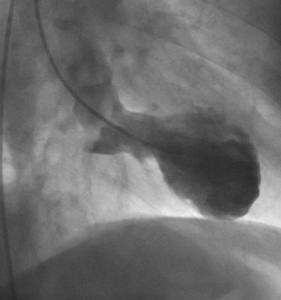Takotsubo Cardiomyopathy is a transient syndrome that mimics an acute myocardial infarction(MI) and patients present with left ventricular apical akinesia. It has been called ‘The Broken Heart Syndrome’ and was first described in Japan in 1990.
Takotsubo translates to ‘Octopus Pot’, an example of which you see here, used for octopus fishing. It also resembles the left Ventricle of this disease.
95% of patients recover within 4-8 weeks, however in about 20% of cases there are complications that can include left ventricular failure, cardiogenic shock and ventricular arrhythmias.
An emotional or physical stressor seems to trigger the event and although there is no real consensus as to the cause, stress-induced catecholamine release leading to myocardial stunning is the most commonly discussed cause. Patients present with classic findings of acute myocardial infarction. They have chest pain, ST elevation on ECG(although usually of low amplitude) and they have, in most cases, elevated cardiac enzymes. Its occurs in approximately 2% of those suspected of having an acute MI (1) and approximately 90% of cases involve postmenopausal women(2).
Our approach in the emergency department is the same as for all those other patients presenting with chest pain and ECG changes, i.e. aspirin and vasodilators. Beta blockers may assist here. A transthoracic echo if available is a quick way to diagnose wall motion abnormalities i.e. akinesia of mid segment and apical segment of left ventricle.
Beware QT prolongation that can occur leading to Torsades- treatment is with Magnesium.
Left Ventricular Failure, can be treated simply with vasodilators and diuretics etc.. However beware the Left ventricular failure and hypotensive Takotsubo patient. In these patients there is effectively a left vernacular outflow obstruction due to a hyperkinetic basal segment and dyskinetic apical segment. Inotropes may worsen the situation and an intra-aortic balloon pump is the treatment of choice.
 1 Bybee KA et al. Clinical characteristics and thrombolysis in myocardial infarctionfame counts in women with transient left ventricular ballooning syndrome. Am J Cardiol. Aug 1 2004;94(3):343-346
1 Bybee KA et al. Clinical characteristics and thrombolysis in myocardial infarctionfame counts in women with transient left ventricular ballooning syndrome. Am J Cardiol. Aug 1 2004;94(3):343-346
2 Gianni M et al. Apical Ballooning syndrome or takotsubo cardiomyopathy: a systematic review. Eur Heart J July 2006:27(13):1523-29




